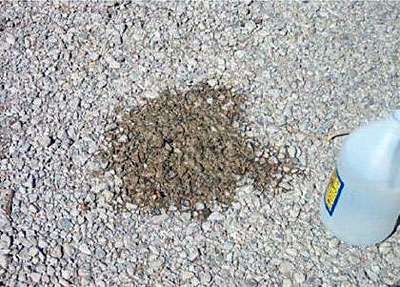Pervious Concrete
Testing and Inspection
pervious concrete | why use it? | properties | installation | testing | success stories | faqs
Pervious concrete can be designed to attain a compressive strength ranging from 400 psi to 4000 psi (2.8 to 28 MPa), though strengths of 600 psi to 1500 psi (2.8 to 10 MPa) are more common. Pervious concrete, however, is not specified or accepted based on strength. More important to the success of a pervious pavement is the void content. Acceptance is typically based on the density (unit weight) of the in-place pavement. An acceptable tolerance is plus or minus 5 lb per cubic feet (80 kg/ml) of the design density. This should be verified through field testing.
 The fresh density (unit weight) of pervious concrete is measured using the jigging method described in ASTM C 29. Slump and air content tests are not applicable to pervious concrete. If the pervious concrete pavement is an element of the stormwater management plan, the designer should ensure that it is functioning properly through visual observation of its drainage characteristics prior to the opening of the facility.
The fresh density (unit weight) of pervious concrete is measured using the jigging method described in ASTM C 29. Slump and air content tests are not applicable to pervious concrete. If the pervious concrete pavement is an element of the stormwater management plan, the designer should ensure that it is functioning properly through visual observation of its drainage characteristics prior to the opening of the facility.
Questions have been raised about the freeze-thaw durability of pervious concrete. Even though most experience with pervious concrete has been in warmer climates, recently there have been several pervious concrete projects in colder climates. Pervious concrete in freeze-thaw environments must not become fully saturated. Saturation of installed pervious concrete pavement can be prevented by placing the concrete on a thick layer of 8-24 inches (200 to 600 mm) of open-graded stone base. Limited laboratory testing has shown that entrained air may improve the freeze-thaw durability even when the pervious concrete is in a fully saturated condition. However, the entrained air content cannot be verified by any standard ASTM test procedure.
The EPA recommends that pervious concrete pavement be cleaned regularly to prevent clogging. Cleaning can be accomplished through vacuum sweeping or high-pressure washing. Even though pervious concrete and the underlying soil provide excellent filtration capabilities, all of the contaminants may not be removed. In critical situations to preserve the quality of ground water, stormwater testing is recommended.


